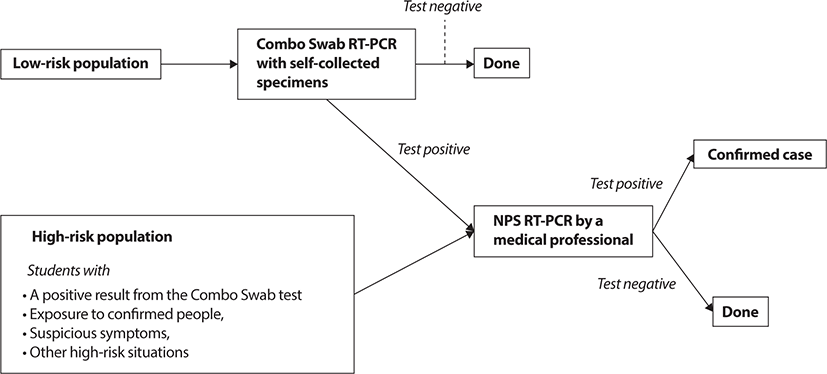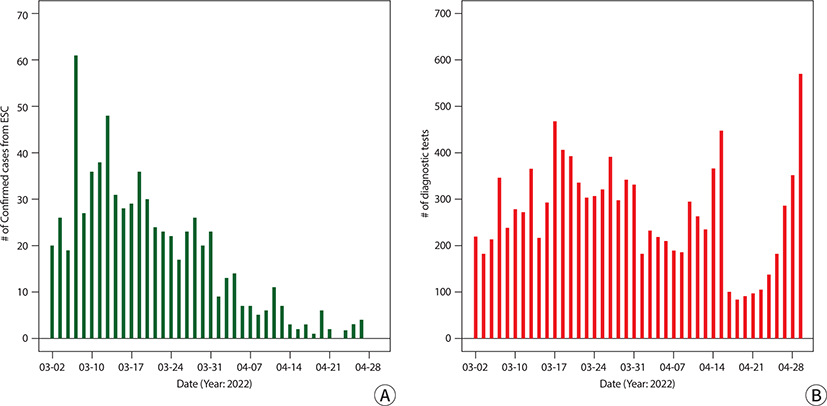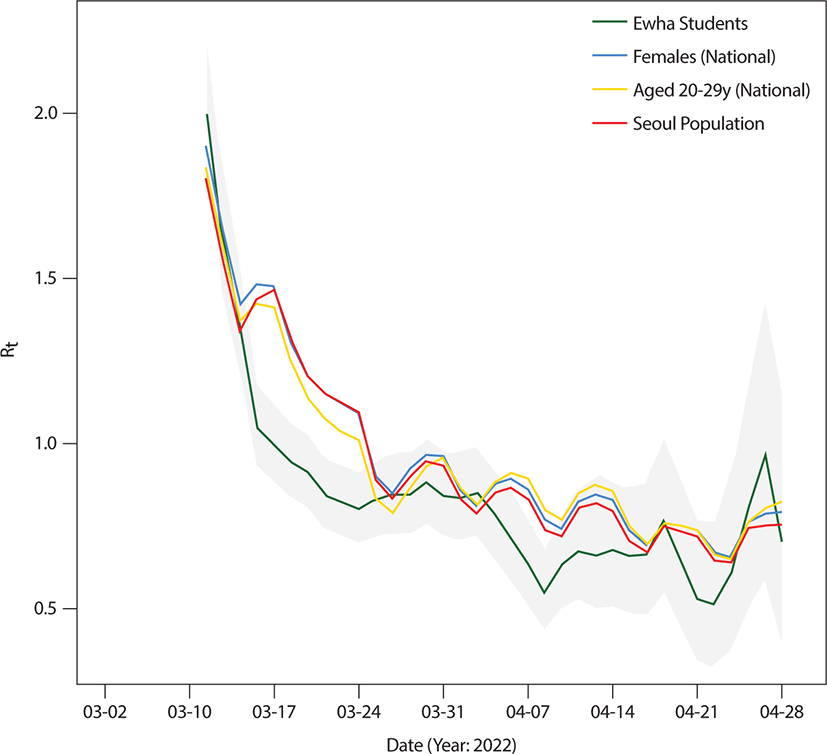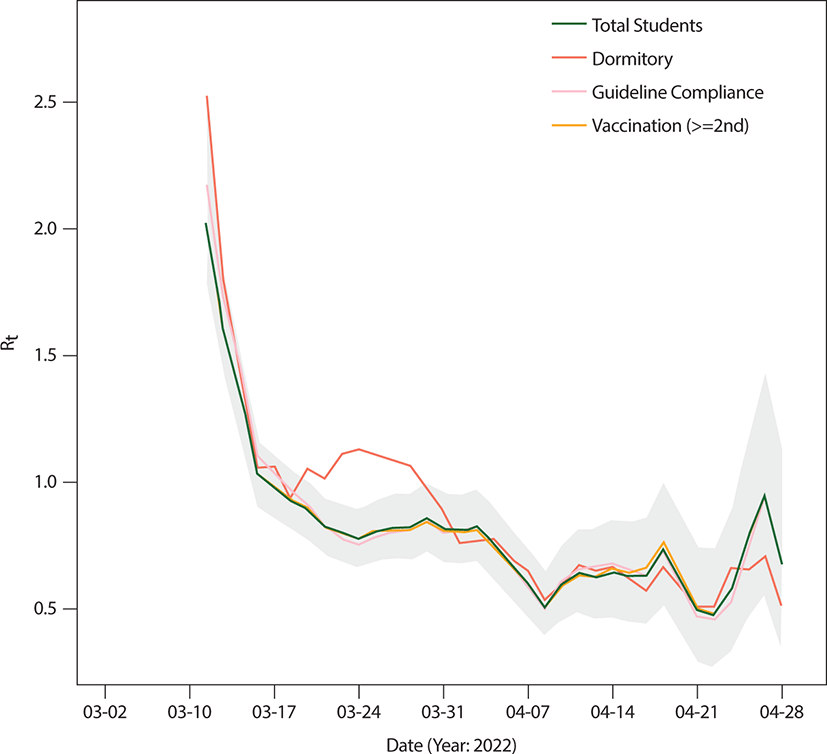Introduction
As of Aug 12, 2022, more than 580 million confirmed cases of COVID-19 have been reported globally, more than 6 million of whom have died due to related complications (WHO Coronavirus Dashboard - URL: http://covid19.who.int, access date: Aug 13, 2022) [1]. Clearly, South Korea (hereafter, Korea) was not an exception to the pandemic. In Korea, more than 21 million cases of confirmed COVID-19 and more than 25,000 related deaths were recorded by Aug 12, 2022 [1]. Although the number of confirmed cases in the country was <640,000 before the period of Omicron wave began (Jan 2022 onward), the spread of COVID-19 rapidly increased since then and the number of cumulative confirmed cases increased from 635,250 (Jan 01, 2022) to 17,237,878 (Apr 30, 2022) [2].
COVID-19 has drastically changed the education system worldwide. For example, in the US alone, >1,300 colleges and universities have suspended the traditional face-to-face classes, closed campuses, and/or have begun implementing different instruction approaches (in-person, online, and hybrid) [3]. Similarly, in Korea also, most educational institutions have started distance online learning classes. However, it remains to be seen whether and how campuses will reopen [4], and what is the impact of COVID-19 restrictions on the quality of education, student well-being, and public health, as well as returns to the local economy [5].
In the US, quarantine strategies including basic preventive measures (e.g., face coverings, physical distancing, and handwashing), on-campus arrival protocols (e.g., recommendation for asymptomatic COVID-19 testing and sequestration for the first 7 days of campus reopening), and periodic asymptomatic surveillance testing are recommended for campus reopening and restarting in-person classes [6]. The Ministry of Education of Korea announced the educational operation plan for the first semester of 2022 by utilizing the high vaccination rate of 20–29-year-old population (97.3%; at least once as of April 4). One of the main goals of campus reopening was the sustenance of in-person classes through autonomous quarantine strategies [7]. In accordance with the announcement, Ewha Womans University (Seoul, Korea) has launched an on-campus COVID-19 response system called the Ewha Safety Campus (ESC) Project [8]. This response project aimed to normalize the educational operation and implement in-person classes by reducing the transmission risk among students and staff and by establishing sustainable management plans against COVID-19. The core element of the ESC Project is the use of RT-PCR tests to diagnose COVID-19 for all members of Ewha Womans University at no cost for better accessibility of the testing [8], and the University announced the operation of ESC project to all school members both online and offline (the testing station was piloted on Feb 22, 2022).
This study evaluates the effectiveness of the ESC Project in reducing and containing the COVID-19 transmission. We calculate the daily reproduction number (Rt) of the confirmed cases to examine whether the ESC Project made any reduction in the transmissibility in the participants compared to that in the general population. We also investigate the transmission risk in vulnerable student groups to obtain epidemiological evidence for establishing differentiated on-campus COVID-19 action plans based on the residential type and compliance with quarantine policies and vaccination.
Methods
The ESC was launched on Mar 2, 2022. The pilot period was from Feb 22 to March 1. Any students of Ewha Womans University could participate in this project. The school strongly recommended using the ESC by mobile messages for students who were symptomatic, those who had close contact with confirmed cases, students in dormitories, or those who used crowded facilities; however, all students and school members voluntarily determined whether to use the ESC or the public community health centers to get a diagnostic test. All ESC exams had to be scheduled using the online reservation system via the Ewha Womans University Portal. During the study, we collected information on the date of testing, sex, age, dormitory residence, compliance with quarantine policies, and the vaccination stage of each participant. RT-PCR diagnostic tests for COVID-19 were provided to all participants of the project from Mar 2 to Apr 30, 2022. During the study period, 16,745 tests were performed on 6,240 students. We excluded 3,020 cases (1,166 students) that did not consent to participate in this research. Thus, our final study population includes 11,348 cases (3,220 students).
The variable on compliance with quarantine policies was self-reported and dichotomized to indicate whether a participant complied with all recommended quarantine policies, namely wearing a facial mask, washing hands, avoiding unnecessary social gatherings, and avoiding communal facilities. The vaccination-stage variable included the self-reported vaccination stage from none to the third dose of vaccine. We defined the fully vaccinated case as the participant who had received second and/or third dose of vaccine, regardless of the vaccine type.
RT-PCR tests with two different types of specimens were conducted on the ESC cohort for COVID-19 diagnosis. The test kits were provided by Seegene Medical Foundation free of cost [9]: 1) Combo Swab with self-collected specimens from the nasal and oral cavity under the supervision of a healthcare professional (hereinafter "Combo Swab RT-PCR"), and 2) nasopharyngeal swab (NPS) RT-PCR conducted by a medical professional (hereinafter "NPS RT-PCR"). The Combo Swab RT-PCR test was used for low-risk students who wanted to undergo a COVID-19 test. In contrast, the NPS RT-PCR test was used for high-risk students who tested positive for the Combo Swab test, were in contact with people with confirmed COVID-19, exhibited suspicious symptoms, and/or were exposed to other high-risk situations. These tests were performed at two separate testing stations, called Ewha Safety Stations (ESS). The ESS were open on weekdays and closed on weekends and holidays. Detailed testing procedures are shown in Fig. 1. Although two types of RT-PCR tests were conducted on the ESC cohort, we defined confirmed cases as only those who tested positive on NPS RT-PCR based on the guidelines of the Korean Society for Laboratory Medicine [10].

We obtained daily counts of confirmed cases of COVID-19 of Korea from Mar 2 to Apr 30, 2022, by using the open data of the Korea Disease Control and Prevention Agency (KCDA) [2]. The data were stratified based on the residential region, age (0–19 yr, 20–39 yr, 40–59 yr, 60–79 yr, and 80+ yr), and sex of the patients. To increase comparability with the students of Ewha Womans University, we analyzed daily confirmed cases from the general population for women, people aged 20–39 years, and people living in Seoul.
We estimated the daily reproduction number (Rt) [11] during the study period following Cori et al.’s method (using the EpiEstim package in R version 4.0.3) [11,12].Rt indicates the average number of new infections caused by a single infected person at timeRt in the people susceptible to infection. It denotes the power of transmission (i.e., transmissibility) [11,13].Rt was calculated based on a combination of the observed daily confirmed cases and the distribution of the serial interval (the time interval between infection and subsequent transmission). Based on a previous Omicron variant study in Korea, we calculatedRt with the serial interval assumed to follow a normal distribution with a mean of 3.78 days and a SD of 0.76 days [14] with a 14-day time window [11]. We calculated theRt series of Ewha university students (via ESC cohort) and for each general population (women, people aged 20–29 years, and Seoul residents). We also estimatedRt for students living in dormitories, those complying with quarantine guidelines, and those who are fully vaccinated. In addition to Rt, to assess the different vulnerability to infection, we calculated the positivity rate (%) of the students based on their compliance with all quarantine guidelines and whether they are fully vaccinated.
Results
From Mar 2 to Apr 30, 2022, 11,348 applications (Combo-swab or NPS RT-PCR tests) were recorded on the ESC cohort (Fig. 1). A total of 711 confirmed cases of COVID-19 were reported (positivity rate: 6.27%; Table 1), with 264 cases for students living in dormitories (positivity rate: 3.52%), 679 cases for students who answered that they complied with all quarantine guidelines (positivity rate: 6.06%), and 697 cases for students who said that they were fully vaccinated (positivity rate: 6.22%; Table 2). During the same period, 5,524,226, 1,444,505, and 1,954,871 confirmed cases were reported for women, people aged 20–29 years, and people living in Seoul (Table 3).
| Period | The number of confirmed cases | The number of applications | Positive rate (%) |
|---|---|---|---|
| Total period (Mar 02 to Apr 30, 2022) | 711 | 11,348 | 6.27 |
| March | 607 | 6,519 | 9.31 |
| April | 104 | 4,829 | 2.15 |
| Population | Total number of confirmed cases | Average confirmed cases/Day |
|---|---|---|
| Total | 10,130,252 | 235,587.3 |
| Females | 5,524,226 | 128,470.4 |
| Aged 20−29 | 1,444,505 | 33,539.1 |
| Seoul residents | 1,954,871 | 45,462.1 |
Students who answered that they complied with all quarantine guidelines (6.06%) showed lower positivity rates than those who did not comply (20.0%) during the study period (Table 2). Students who were fully vaccinated (6.22%) also had lower positivity rates than those who were not (10.37%). Fig. 2 displays the temporal trends of daily confirmed cases (left) and daily number of diagnostic tests (right) for Ewha students through the ESC cohort. The infection peak was observed around Mar 5–10 (Fig. 2).

The initial Rt of Ewha students was slightly higher (or similar) than that of the general populations (Fig. 3). However, the Rt of Ewha students decreased faster and was smaller across all study periods after two weeks of the initiation of the ESC Project, compared to that in the general populations.

Among the ESC subgroups, changes in Rt are presented in Fig. 4. The Rt for student groups at Ewha Womans University and those living in dormitories was higher, indicating a higher transmissibility than that of the total students. However, we could not observe an evident difference in the Rt distribution based on compliance with quarantine guidelines and full vaccination.

Discussion
This study examined the effectiveness of the ESC Project that aims to reduce COVID-19 transmission in students by conducting proactive diagnostic tests. The results showed that the ESC Project might be effective in reducing the transmissibility among the students to a higher extent than that in general populations. Furthermore, the ESC Project also investigated student groups vulnerable to infection by assessing group-specific Rt or positivity rates and revealed that students who live in dormitories, those who did not comply with all quarantine guidelines, and those who were not fully vaccinated were more vulnerable to COVID-19 infection than other students.
To the best of our knowledge, this is one of the few studies that investigated the efficacy of an on-campus COVID-19 action plan and the resulting effectiveness of Rt based on proactive testing. Rt quantifies the contagiousness of the disease and estimates the incidence time series, which can be used to evaluate whether the intervention affected the transmission of infection. Estimation and comparison of Rt, which indicate the power of transmission (i.e., transmissibility), have been widely used in epidemiological studies to assess and provide insights into the effectiveness of intervention policies [11,13,15]. Thus, the results of this study may be used to demonstrate the effectiveness of the ESC cohort to reduce the spread of COVID-19 on campus.
In the case of South Korea, rapid diagnosis and rapid isolation are key to the prevention of transmission [16]. This was evaluated as a successful quarantine in 2020. Health authorities implemented a real-time RT-PCR analysis method to immediately detect SARS-CoV-2. In a study reported from another campus, when positive cases were quickly identified and quarantined, the transmission of infection greatly reduced. Furthermore, COVID-19 cases could be accurately confirmed by conducting repeat RT-PCR testing, which helped in quickly responding to cases such as prompt screening and in quarantining individuals who come in contact with cases [17-19]. The ESC Project also seems to have been effective in reducing the spread of infection on the Ewha campus as it recommended and implemented repeated RT-PCR tests, without any economical barrier, not only for symptomatic patients but also for the early detection of asymptomatic patients.
The effectiveness of the ESC cohort should be interpreted based on changes in the national COVID-19 diagnostic guidelines. Earlier, everyone in Korea was eligible for free RT-PCR tests at any national screening center. However, the Korean Disease Control and Prevention Agency changed the eligibility for free RT-PCR tests from Feb 04, 2022, in order to address the drastically increased confirmed cases due to the Omicron variant. Thus, only high-risk groups (people aged 60 or older, those referred from an epidemiological investigation or with the note of a medical doctor, those who received positive test results from rapid antigen tests, and/or those working at high-risk places such as hospitals) could undergo free RT-PCR tests during our study period at national screening centers. Students who were generally classified as the low-risk group ceased to be eligible for no-cost RT-PCR tests [10].
The ESC Project provided RT-PCR diagnostic tests at no cost to students. In addition, the ESC cohort tried to increase its accessibility by employing test recommendations based on the school’s epidemiological inspections and internet-based application procedures. As a result, among a total of 1,205 confirmed students reported at Ewha Womans University through Apr 30, 2022 (including confirmed cases at external institutes such as screening centers operated by local governments), the ESC cohort detected 703 students with confirmed COVID-19 infection (58.3%). Increasing accessibility to accurate diagnostic tests has been consistently identified as a crucial factor to decrease the risk of infection and local transmissibility [12]. Thus, we conjecture that providing free and proactive RT-PCR tests considerably contributed in reducing the viral transmission in Ewha students compared to that in the general population.
The study has four limitations. First, since Mar 14, 2022, the period that was included in our study period, antigen tests performed by medical staff have been approved to confirm COVID-19. Therefore, the results regarding the general populations from this period should be interpreted carefully when it was compared with the ESC results based on PCR, and it should be acknowledged that there might be a risk of biases. However, the Korean CDC reported that because of a high prevalence of the Omicron variant, the sensitivity of the antigen tests performed in the Korean respiratory disease professional clinics in Feb 2022 was 94.7% compared to PCR tests (KCDC Press release on Mar 14, 2022; URL: https://www.kdca.go.kr/board/), thus we cautiously conjecture that the potential biases due to the antigen tests were not substantially large. Second, because we could not access the data of students who did not consent to participation in this research and who did not use ESS to have a diagnostic test, we cannot exclude the probability of selection bias resulting from voluntary participation. In particular, previous studies reported that voluntary participants can be younger, more professionally active, and more often had a history of contact with COVID-19 confirmed cases, and the factors generally negatively affect the generalizability of the study results via overestimation problems [20,21]. Third, variables used in this study regarding compliance with quarantine guidelines and vaccination relied on self-reported information. This might have led to an overestimate in the number of students who complied with quarantine guidelines and were fully vaccinated. Finally, only female students registered in a university in Seoul were included in the ESC cohort. Thus, our results are limited and it is difficult to extend them to university students and/or general population.
In this study, we assessed the effectiveness of an ESC cohort. Our study results provide scientific evidence for establishing autonomous, effective, and sustainable on-campus action plans against COVID-19 based on no-cost and proactive RT-PCR tests. Further, our results support the necessity of applying more intensive managing strategies for students who live in communal resident places, did not comply with quarantine guidelines, and who are not fully vaccinated.

